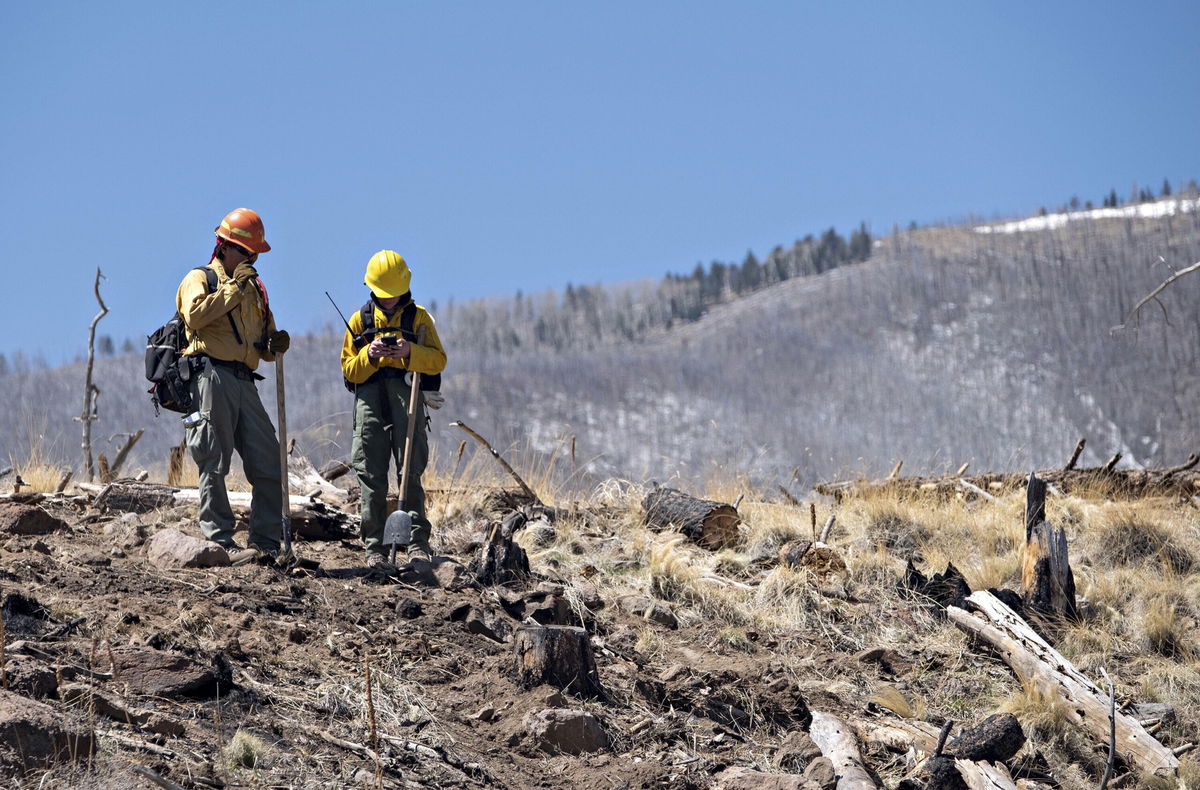Millions in the Southwest could see ‘dangerous and dire’ weather take shape, weather service says

Over 4 million in the Southwest face an 'extremely critical' fire danger Friday as strong winds hit the region. Advisors from the Coconino National Forest study the Tunnel Fires impact April 21
By Haley Brink, CNN meteorologist
Hot, dry and windy conditions mean drought-stricken areas of the Southwest face an “extremely critical” threat of fire Friday, from central and eastern New Mexico to eastern Colorado, including Denver.
Other higher population centers threatened include Albuquerque in New Mexico and Colorado Springs in Colorado.
“A dangerous and dire weather situation will take shape today,” the National Weather Service (NWS) in Albuquerque said. “Extremely critical fire weather is possible today when very strong winds will combine with exceptionally low humidity, above normal temperatures, and an unstable airmass.”
Some sites in the southern and central high plains are seeing “extremely critical strength winds” — meaning sustained winds of at least 30 mph — and temperatures were already in the 80s across eastern Colorado, the Storm Prediction Center (SPC) said in a Friday afternoon update.
More than 10 million people from Arizona to Nebraska are under red flag warnings Friday, meaning conditions are perfect for wildfires to start and to spread.
“Any fire that starts will have the potential to spread rapidly, and would be difficult if not impossible to control,” the NWS office in Boulder said.
Numerous fire warnings and evacuations were issued Friday afternoon, from New Mexico to Nebraska.
Extreme winds with gusts between 55-65 mph are fueling dangerous wildfire conditions in the San Miguel and Mora counties in New Mexico.
More than 20 communities are already under evacuation order with at least eight communities ordered to prepare for evacuation due to the 3,000-acre Calf Canyon Fire, according to a joint release from both counties.
“When the winds are this bad…and it’s so dry here, we need everyone to be prepared to potentially have to evacuate at a moment’s notice,” Wendy Mason, State Forestry Wildfire Prevention and Communications Coordinator, told CNN.
Mason says planes are not able to capture acreage data due of the winds.
The residents of about 200 homes in the Pueblo of Jemez, about 70 miles west of Santa Fe, were ordered to evacuate Friday, according to Sandoval County officials. The new Cerro Pelado Fire spread through the tribal community because of the intense winds and dry conditions throughout the state.
Sandoval County Public Information Officer Stephen Montoya said it is too early for firefighters to determine the scope of the burn.
Relative humidity values as low as 5% and sustained winds of 30 to 40 mph with gusts from 60 to 70 mph are possible.
Some areas could see scattered wind gusts reaching 80 mph, strong enough to topple trees or knock over utility poles.
Wind gusts topped hurricane-force Friday afternoon in Colorado and New Mexico. Raton, New Mexico, reported a gust of 75 mph and Springfield, Colorado, reached 76 mph.
“These winds could potentially be catastrophic for ongoing wildfires or any new ignitions,” the NWS in Albuquerque said.
Dry thunderstorms are also a concern, according to the SPC.
These thunderstorms can produce lightning that can start new fires, with very little to no rain. The area at greatest risk for dry thunderstorms overlaps parts of the “extremely critical” fire threat near the Colorado/Kansas border down to the New Mexico/Texas border.
Much of the area is suffering from prolonged, severe drought that’s a symptom of the growing climate crisis. New Mexico’s drought area has more than tripled since January and now covers more than 60% of the state.
Friday’s is the seventh extreme fire danger issued since December, and the number of people in the extreme risk area — 4.2 million — is higher than all the previous six combined.
Last year, there were only two extreme risk days. That followed seven in 2020 and 11 in 2019.
In the past two years, Colorado has experienced the three largest wildfires in its history, Gov. Jared Polis said Friday in announcing a wildfire preparedness package designed to provide relief for people affected by the fires and invests $15 million in tools to fight future fires.
“We know that this issue is about more than just one fire,” Polis said. “It’s really about tackling the increased fire threat. It’s a combination of climate, drought, increased population, and increased utilization of our wild lands, all conspiring together to lead to higher risk levels than Colorado has ever had in our history.”
More than 19,700 wildfires have been reported this year, more than any year-to-date period of the last 10 years, according to the National Interagency Fire Center. The 10-year-average for the period is 13,720.
The-CNN-Wire
™ & © 2022 Cable News Network, Inc., a WarnerMedia Company. All rights reserved.
CNN’s Brandon Miller and Hannah Sarisohn contributed to this report.
